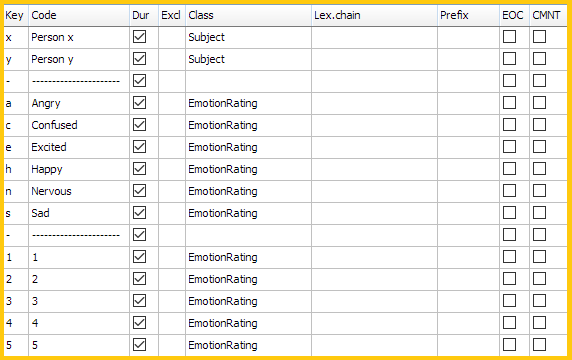Whenever Combine new Codes with previous Cell content is selected in the Observation Settings, INTERACT enters, per Event, all Codes that belong to the same Class into the same field. This can result in Codes like 'Smile_3' or '359'.
This coding option can be used to create combined Codes while coding or when adding information to an existing Event into a Class that already contains information from a previous coding pass.
Example: Suppose you are observing a social interaction of three people. We want to log the duration someone is talking and the emotional state of this person. A choice of possible emotions is: [s]ad, [h]appy, [e]xited, [n]ervous, [a]ngry and [c]onfused. The intensity of the emotion also needs to be logged, based on a scale 1 to 5.
Because of the coding structure for this research example, we need to combine the Emotion and the Intensity. Therefore, our observations are collected in only two Classes: 'Subject' and 'EmotionRating'.
We use the coding mode Lexical (post-hoc) in this example, but it works for the coding modes Refine existing Events and Complex as well.
▪Define or open a set of Code definitions, with Codes like shown in the picture:
▪Create a new empty document.
▪Select the coding mode Lexical (post-hoc) and select Combine codes (leave the Pause... and Start... options selected as well)
▪Click ![]() .
.
▪Click ![]() or press F7, to start your multimedia file(s).
or press F7, to start your multimedia file(s).
▪As soon as a one of the test persons starts talking, press the SPACEBAR, to start the first Event .
▪Press the SPACEBAR again, to end the Event whenever the person stops talking.
As soon as the end of this behavior is set, the multimedia file pauses and an additional symbol appears in the Observation Controls, next to the Timer:

As long as this Lexical chain indicator ![]() is visible, the lexical chain mode is active. This means that INTERACT won't leave the just logged Event, enabling you to enter multiple Observation Codes.
is visible, the lexical chain mode is active. This means that INTERACT won't leave the just logged Event, enabling you to enter multiple Observation Codes.
For our example we continue as follows:
▪Press [y], to enter the fact that Person Y was talking.
▪Press [n], to enter the fact that this person was nervous.
▪Press [2], to specify the intensity of this person's emotional state.
By now, the following Codes were entered:
•In Class 'Object' the Code 'Person Y'
•In Class 'Emotion' the Observation Codes 'nervous' + '2'

We continue our coding session, presuming that the next person starts talking right away:
▪Press the SPACEBAR, to start the next Event.
The video starts playing, the Lexical chain indicator ![]() disappears and a new Event is created.
disappears and a new Event is created.
▪Stop the Event as soon as this second person stops talking.
The video pauses and the Lexical chain indicator ![]() re-appears.
re-appears.
▪Press [x] to log the fact that Person X was talking.
▪Press the keys describing this persons state of emotion (e.g. [a] for his being Angry and [3] for his anger level).
▪Continue as described above.
Note: INTERACT needs to be 'told' whenever you have finished coding the current Event. This is done either automatically, by pressing the SPACEBAR to directly log a new Event or by manually disabling the 'Lexical' mode. To exit the lexical mode, press ESC or click on the Lexical chain indicator ![]() .
.
Break Event chain
If you do not want to create Events that continuously follow each other, do as follows:
▪Click ![]() or press F7, to manually start your multimedia file(s).
or press F7, to manually start your multimedia file(s).
▪Press the SPACEBAR as soon as anything worth logging happens.
▪Continue to add your Codes, to the currently logged Event, as described above.
